Mining in or Close to Protected Areas
- Richprins
- Committee Member
- Posts: 76082
- Joined: Sat May 19, 2012 3:52 pm
- Location: NELSPRUIT
- Contact:
Re: Mining in or Close to Protected Areas
Please check Needs Attention pre-booking: https://africawild-forum.com/viewtopic.php?f=322&t=596
- Lisbeth
- Site Admin
- Posts: 67551
- Joined: Sat May 19, 2012 12:31 pm
- Country: Switzerland
- Location: Lugano
- Contact:
Re: Mining in or Close to Protected Areas
Creecy beefs up Zululand rivers pollution probe after coal waste collapse
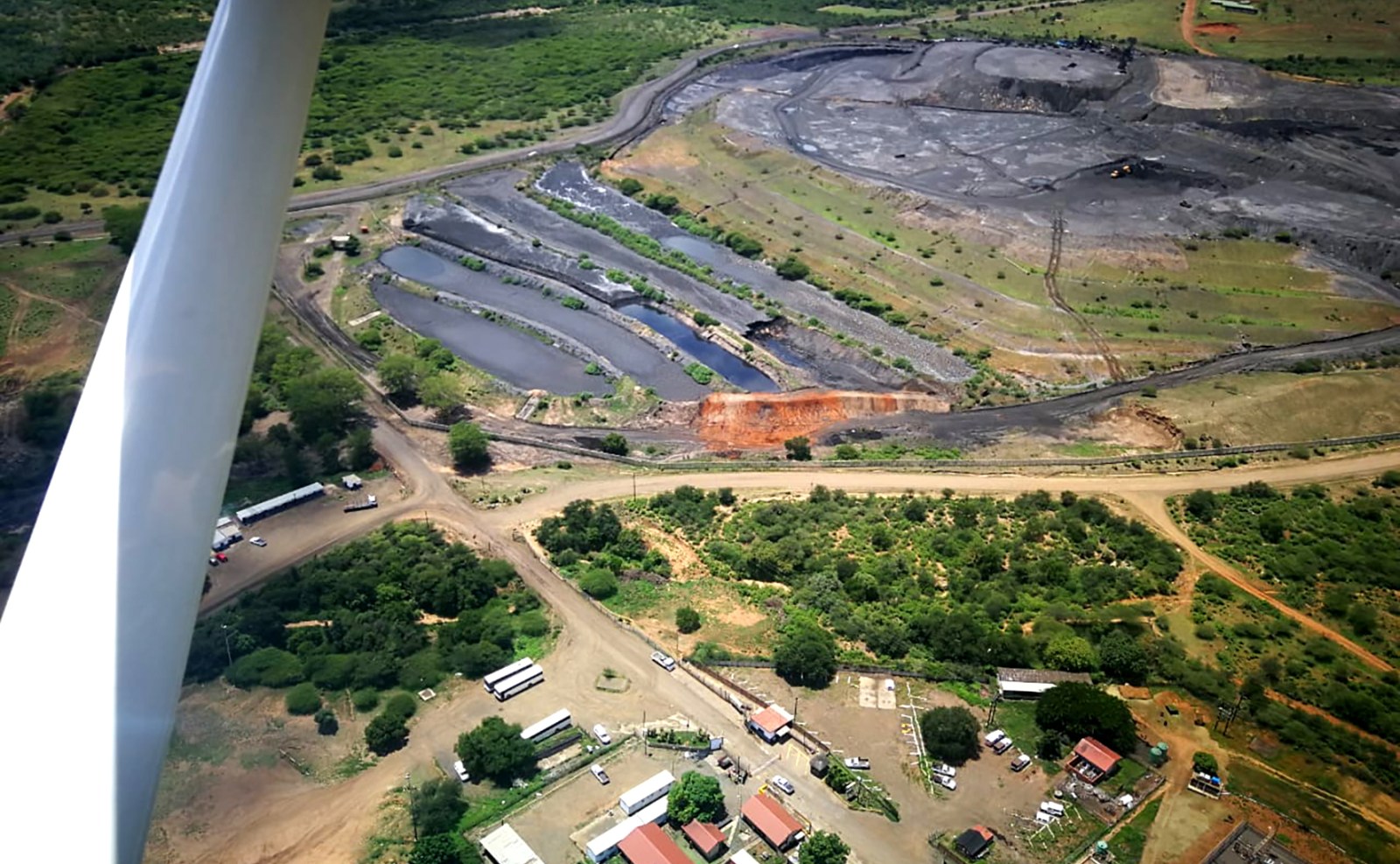
An aerial view of the Zululand Anthracite Colliery (ZAC) colliery near Ulundi, showing parts of the pollution control dams that burst last month. (Photo: Supplied)
By Tony Carnie | 17 Jan 2022
Inspectors from the Green Scorpions are visiting the Zululand Anthracite Colliery this week, hoping to shine a light on a 35-year legacy of environmental pollution and voluminous water consumption by one of the country’s largest anthracite coal suppliers.
................................................................................................................................................................................
A team of Environmental Management Inspectors (EMIs) from the national Department of Forestry, Fisheries and the Environment has been deployed to KwaZulu-Natal to boost a multi-department investigation into the collapse of a waste slurry dam at the Zululand Anthracite Colliery (ZAC) anthracite coal mine.
An estimated 1.5 million litres of liquid coal waste poured into the Black Umfolozi and White Umfolozi River system after the 24 December slurry leak, raising concern about the health of people, animals and the broader environment exposed to toxic and acidic wastes.
While the recent heavy rains have helped to dilute and disperse the pollution, the mining waste nevertheless contains a variety of several toxic heavy metals and chemical compounds that include mercury, manganese, arsenic, copper and lead.
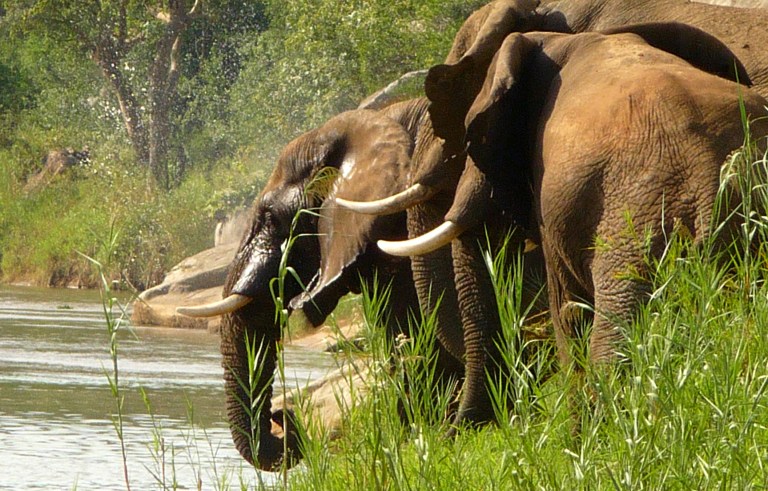
Elephants drink from a river in the Hluhluwe-iMfolozi game reserve. (Photo: Wilderness Leadership School)
Barbara Creecy, the Forestry, Fisheries and the Environment Minister, confirmed on Friday that her department had deployed a team of senior inspectors after she received a request for technical support from her provincial counterpart, KZN environment MEC Ravi Pillay.
“The team will support the ongoing efforts to address the impacts of the spill that is affecting rural communities and the Hluhluwe-iMfolozi Park as well as posing a risk to the iSimangaliso Wetland Park,” she said.
The mine, which opened in 1987, is located on the north-west boundary of the Hluhluwe-iMfolozi Park, one of Africa’s oldest game reserves and wilderness areas, and is surrounded by several subsistence farming communities that rely on rivers, streams and boreholes for human consumption and to water their livestock and crops.
Currently owned by the Menar group, which took over in 2016, the mine has previously been owned by BHP Billiton, Riversdale Mining and Rio Tinto. The land is owned by the Zulu monarch’s Ingonyama Trust, which receives royalties from several mineral operations across the province.
Over recent decades, the mine has come under fire from several community members, environmental groups and the provincial conservation agency (Ezemvelo KZN Wildlife) due to illegal mine expansion, pollution and the increasing volume of water consumption, especially during droughts and dry seasons.
ZAC paid a R497,000 fine in 2014 for operating three mine shafts illegally, some for nearly a decade. More recently, the SABC television programme 50/50 highlighted complaints by local communities about sinkholes, polluted water and claims that smaller rivers have dried up due to mining operations and water abstraction.
Last year, Ezemvelo also lodged a formal objection with the national Water Tribunal after ZAC was granted a new Water Use Licence, allowing it to open a new mining shaft barely 4km from the Hluhluwe-iMfolozi park boundary.
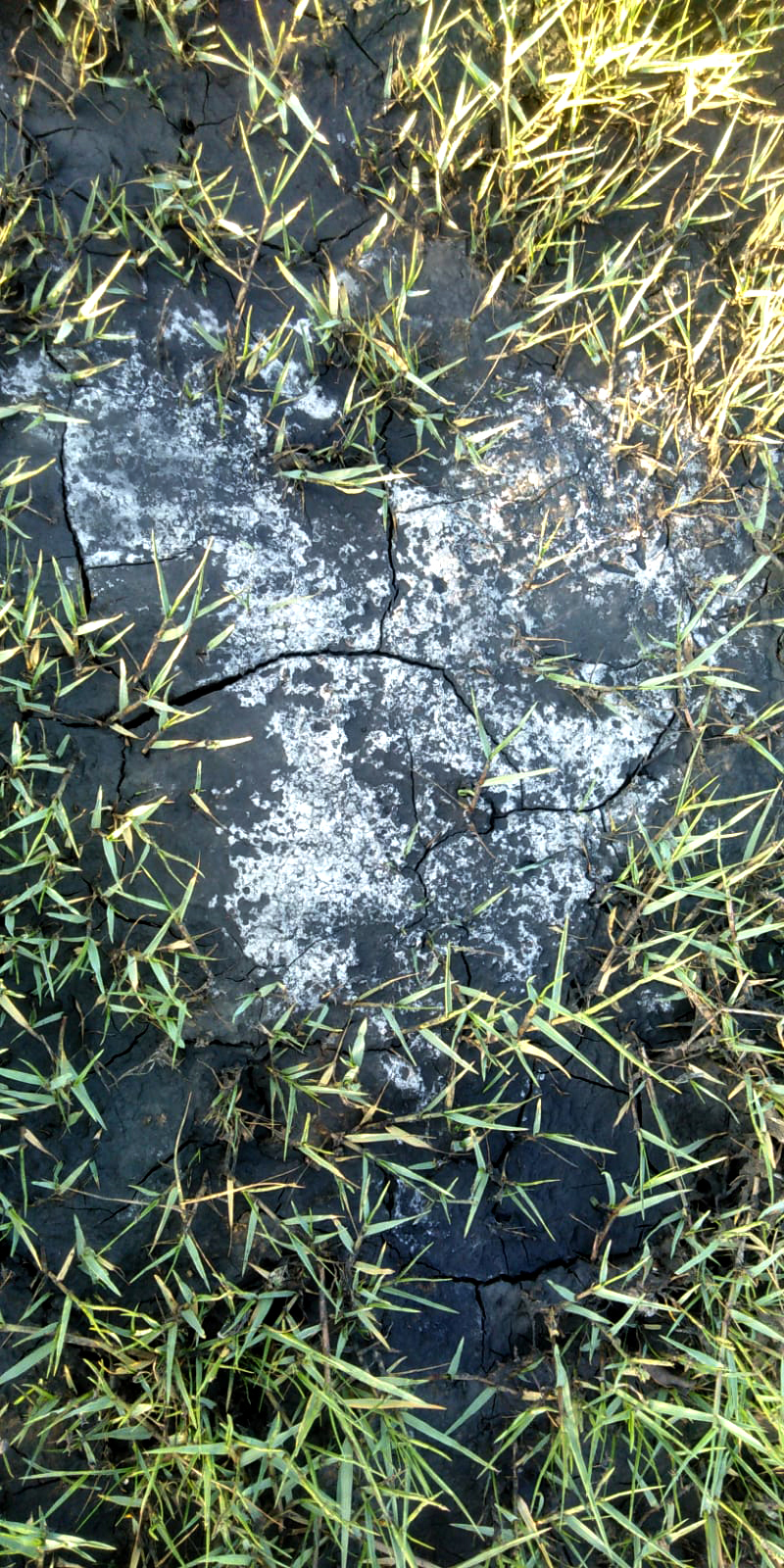
A white powdery substance coats the surface of soils downstream from the collapsed Zululand Anthracite Colliery (ZAC) slurry dam. It contained a mixture of carbon, antimony, arsenic, barium, cadmium, chrome, cobalt, copper, lead, manganese, mercury, molybdenum, nickel, selenium, vanadium and zinc. (Photo: Supplied)
Complaining about the “untransparent and flawed public participation process” the conservation agency said critical recommendations and guidelines provided by Ezemvelo KZN Wildlife and other key organs of state appeared to have been ignored.
ZAC and its groundwater consultants also failed to demonstrate that the new Mngeni Adit would not harm water security of the Hluhluwe-iMfolozi Park and the iSimangaliso Wetland Park World Heritage Site.
“There is, we believe, evidence to demonstrate that ZAC is polluting both ground and surface water and possibly adversely impacting on the ecological reserve of the Black Umfolozi River,” Ezemvelo Conservation Services head Joe Phadima said in a letter to the Water Tribunal.
He said ZAC’s “poor track record in adhering to licence conditions” should also not have been overlooked by the Department of Water and Sanitation (DWS).
“The National Water Act grants a water right to both people in terms of a ‘basic human needs reserve’, and to the environment – the ‘ecological reserve’. The DWS cannot issue a water licence to a mine [or alter an existing one] without providing for and ensuring the adequacy of the reserve.”
While the current mine owners boast about providing piped drinking water for livestock and human consumption at “23 communal taps, at a rate of 2,5 million litres per month” this volume appears to be a small fraction of the water extracted every month from the Black Umfolozi River and boreholes for coal-washing, dust suppression and other mine operations at ZAC.
While Our Burning Planet has not been able to establish the current volumes of river and groundwater used by ZAC every month, it is understood that the mine’s water use licence allows it to extract 519,000m3/year of water from the Black Umfolozi (equating to more than 43 million litres per month).
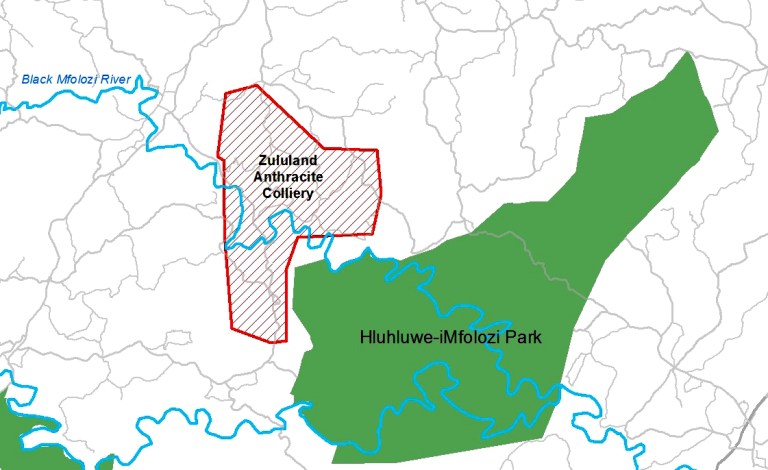
A map showing the approximate boundaries of the Zululand Anthracite Colliery in relation to the Hluhluwe-iMfolozi Park. (Image: Supplied)
Further, according to a new water use licence granted by senior DWS official Trevor Balzer in 2020, ZAC will be permitted to extract another 365,000m3 (365 million litres) from groundwater resources annually for the new Mngeni mine shaft.
The new water-use licence also makes it clear that ZAC is legally obliged to provide potable water to local communities and other users in compensation for water used by the mine.
For the Green Scorpions team currently visiting the ZAC mine, the immediate focus is likely to be on the most recent pollution plume; the underlying reason for the failure of the slurry dam – and also whether ZAC’s pollution control dams have been lined with an impervious layer to prevent groundwater being contaminated.
According to the Menar website, ZAC inherited a situation where most of the mine’s 28 pollution control dams (PCDs) were unlined and it would cost an estimated R90-million to rectify this.
“The purpose of a lining system in a PCD is to minimise leakage of polluted water from the dam that could result in contamination of groundwater resources. This is something that previous owners of ZAC should have done, but the burden and cost of lining now falls on us and as a responsible mining company, we are committed to fulfilling our obligations in this regard,” said ZAC.
It is not clear what progress Menar has made in rectifying the historical legacy of pollution from unlined control dams by previous owners, but in response to questions from Our Burning Planet, ZAC confirmed the slurry that spilled into local rivers last month was likely to contain carbon, antimony, arsenic, barium, cadmium, chrome, cobalt, copper, lead, manganese, mercury, molybdenum, nickel, selenium, vanadium and zinc.
The company said samples from several groundwater pollution monitoring points had been collected and further samples would be collected further downstream towards the Lake St Lucia estuary.
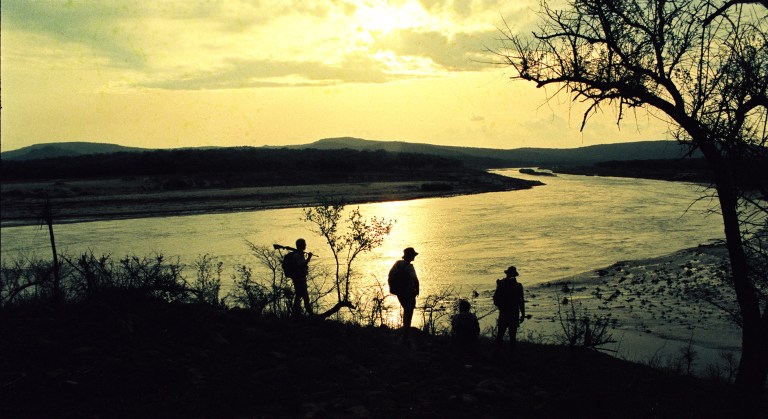
Wilderness hikers and rangers watch the sun setting over the Black Umfolozi River, scene of the recent coal slurry spillage. (Photo: Tony Carnie)
ZAC confirmed that it had not erected any signboards in affected areas to warn people about the potential risks of drinking or using water and soil contaminated by the spill. It said, “Community leaders were briefed on the 24th, 25th, 26th, and 28th December 2021, and 3rd and 6th January 2022. Community leaders provide feedback to communities.”
On whether ZAC believed the dam failure was due to heavy rains or faults in the design or maintenance of the slurry dam wall, ZAC said: “An engineering firm has been appointed to confirm the exact root cause of the failure of the dam wall. This investigation is currently in process.”
The company did not respond directly to queries on whether its slurry dams had sufficient freeboard volume to contain the extra water expected during the summer rainfall season, simply stating: “The dams are operated on a decant system. Highest dam decants into lower dam in a cascading system. One dam is always in a process of being cleaned to generate new capacity. This has been the system in operation at ZAC during all the seasons including the summer rainfall season.”
Creecy said the team from her department will provide on-the-ground support and assistance to the joint operations committee, which is made up of government roleplayers, including the Department of Mineral Resources and Energy, the Department of Water and Sanitation, the KZN Department of Economic Development, Tourism and Environmental Affairs and Ezemvelo KZN Wildlife. DM/OBP

An aerial view of the Zululand Anthracite Colliery (ZAC) colliery near Ulundi, showing parts of the pollution control dams that burst last month. (Photo: Supplied)
By Tony Carnie | 17 Jan 2022
Inspectors from the Green Scorpions are visiting the Zululand Anthracite Colliery this week, hoping to shine a light on a 35-year legacy of environmental pollution and voluminous water consumption by one of the country’s largest anthracite coal suppliers.
................................................................................................................................................................................
A team of Environmental Management Inspectors (EMIs) from the national Department of Forestry, Fisheries and the Environment has been deployed to KwaZulu-Natal to boost a multi-department investigation into the collapse of a waste slurry dam at the Zululand Anthracite Colliery (ZAC) anthracite coal mine.
An estimated 1.5 million litres of liquid coal waste poured into the Black Umfolozi and White Umfolozi River system after the 24 December slurry leak, raising concern about the health of people, animals and the broader environment exposed to toxic and acidic wastes.
While the recent heavy rains have helped to dilute and disperse the pollution, the mining waste nevertheless contains a variety of several toxic heavy metals and chemical compounds that include mercury, manganese, arsenic, copper and lead.

Elephants drink from a river in the Hluhluwe-iMfolozi game reserve. (Photo: Wilderness Leadership School)
Barbara Creecy, the Forestry, Fisheries and the Environment Minister, confirmed on Friday that her department had deployed a team of senior inspectors after she received a request for technical support from her provincial counterpart, KZN environment MEC Ravi Pillay.
“The team will support the ongoing efforts to address the impacts of the spill that is affecting rural communities and the Hluhluwe-iMfolozi Park as well as posing a risk to the iSimangaliso Wetland Park,” she said.
The mine, which opened in 1987, is located on the north-west boundary of the Hluhluwe-iMfolozi Park, one of Africa’s oldest game reserves and wilderness areas, and is surrounded by several subsistence farming communities that rely on rivers, streams and boreholes for human consumption and to water their livestock and crops.
Currently owned by the Menar group, which took over in 2016, the mine has previously been owned by BHP Billiton, Riversdale Mining and Rio Tinto. The land is owned by the Zulu monarch’s Ingonyama Trust, which receives royalties from several mineral operations across the province.
Over recent decades, the mine has come under fire from several community members, environmental groups and the provincial conservation agency (Ezemvelo KZN Wildlife) due to illegal mine expansion, pollution and the increasing volume of water consumption, especially during droughts and dry seasons.
ZAC paid a R497,000 fine in 2014 for operating three mine shafts illegally, some for nearly a decade. More recently, the SABC television programme 50/50 highlighted complaints by local communities about sinkholes, polluted water and claims that smaller rivers have dried up due to mining operations and water abstraction.
Last year, Ezemvelo also lodged a formal objection with the national Water Tribunal after ZAC was granted a new Water Use Licence, allowing it to open a new mining shaft barely 4km from the Hluhluwe-iMfolozi park boundary.

A white powdery substance coats the surface of soils downstream from the collapsed Zululand Anthracite Colliery (ZAC) slurry dam. It contained a mixture of carbon, antimony, arsenic, barium, cadmium, chrome, cobalt, copper, lead, manganese, mercury, molybdenum, nickel, selenium, vanadium and zinc. (Photo: Supplied)
Complaining about the “untransparent and flawed public participation process” the conservation agency said critical recommendations and guidelines provided by Ezemvelo KZN Wildlife and other key organs of state appeared to have been ignored.
ZAC and its groundwater consultants also failed to demonstrate that the new Mngeni Adit would not harm water security of the Hluhluwe-iMfolozi Park and the iSimangaliso Wetland Park World Heritage Site.
“There is, we believe, evidence to demonstrate that ZAC is polluting both ground and surface water and possibly adversely impacting on the ecological reserve of the Black Umfolozi River,” Ezemvelo Conservation Services head Joe Phadima said in a letter to the Water Tribunal.
He said ZAC’s “poor track record in adhering to licence conditions” should also not have been overlooked by the Department of Water and Sanitation (DWS).
“The National Water Act grants a water right to both people in terms of a ‘basic human needs reserve’, and to the environment – the ‘ecological reserve’. The DWS cannot issue a water licence to a mine [or alter an existing one] without providing for and ensuring the adequacy of the reserve.”
While the current mine owners boast about providing piped drinking water for livestock and human consumption at “23 communal taps, at a rate of 2,5 million litres per month” this volume appears to be a small fraction of the water extracted every month from the Black Umfolozi River and boreholes for coal-washing, dust suppression and other mine operations at ZAC.
While Our Burning Planet has not been able to establish the current volumes of river and groundwater used by ZAC every month, it is understood that the mine’s water use licence allows it to extract 519,000m3/year of water from the Black Umfolozi (equating to more than 43 million litres per month).

A map showing the approximate boundaries of the Zululand Anthracite Colliery in relation to the Hluhluwe-iMfolozi Park. (Image: Supplied)
Further, according to a new water use licence granted by senior DWS official Trevor Balzer in 2020, ZAC will be permitted to extract another 365,000m3 (365 million litres) from groundwater resources annually for the new Mngeni mine shaft.
The new water-use licence also makes it clear that ZAC is legally obliged to provide potable water to local communities and other users in compensation for water used by the mine.
For the Green Scorpions team currently visiting the ZAC mine, the immediate focus is likely to be on the most recent pollution plume; the underlying reason for the failure of the slurry dam – and also whether ZAC’s pollution control dams have been lined with an impervious layer to prevent groundwater being contaminated.
According to the Menar website, ZAC inherited a situation where most of the mine’s 28 pollution control dams (PCDs) were unlined and it would cost an estimated R90-million to rectify this.
“The purpose of a lining system in a PCD is to minimise leakage of polluted water from the dam that could result in contamination of groundwater resources. This is something that previous owners of ZAC should have done, but the burden and cost of lining now falls on us and as a responsible mining company, we are committed to fulfilling our obligations in this regard,” said ZAC.
It is not clear what progress Menar has made in rectifying the historical legacy of pollution from unlined control dams by previous owners, but in response to questions from Our Burning Planet, ZAC confirmed the slurry that spilled into local rivers last month was likely to contain carbon, antimony, arsenic, barium, cadmium, chrome, cobalt, copper, lead, manganese, mercury, molybdenum, nickel, selenium, vanadium and zinc.
The company said samples from several groundwater pollution monitoring points had been collected and further samples would be collected further downstream towards the Lake St Lucia estuary.

Wilderness hikers and rangers watch the sun setting over the Black Umfolozi River, scene of the recent coal slurry spillage. (Photo: Tony Carnie)
ZAC confirmed that it had not erected any signboards in affected areas to warn people about the potential risks of drinking or using water and soil contaminated by the spill. It said, “Community leaders were briefed on the 24th, 25th, 26th, and 28th December 2021, and 3rd and 6th January 2022. Community leaders provide feedback to communities.”
On whether ZAC believed the dam failure was due to heavy rains or faults in the design or maintenance of the slurry dam wall, ZAC said: “An engineering firm has been appointed to confirm the exact root cause of the failure of the dam wall. This investigation is currently in process.”
The company did not respond directly to queries on whether its slurry dams had sufficient freeboard volume to contain the extra water expected during the summer rainfall season, simply stating: “The dams are operated on a decant system. Highest dam decants into lower dam in a cascading system. One dam is always in a process of being cleaned to generate new capacity. This has been the system in operation at ZAC during all the seasons including the summer rainfall season.”
Creecy said the team from her department will provide on-the-ground support and assistance to the joint operations committee, which is made up of government roleplayers, including the Department of Mineral Resources and Energy, the Department of Water and Sanitation, the KZN Department of Economic Development, Tourism and Environmental Affairs and Ezemvelo KZN Wildlife. DM/OBP
"Education is the most powerful weapon which you can use to change the world." Nelson Mandela
The desire for equality must never exceed the demands of knowledge
The desire for equality must never exceed the demands of knowledge
- Richprins
- Committee Member
- Posts: 76082
- Joined: Sat May 19, 2012 3:52 pm
- Location: NELSPRUIT
- Contact:
Re: Mining in or Close to Protected Areas
Uprising against proposed coal mine resurges
Residents and stake holders from the Onderberg stand together to oppose a revived application for an opencast coal mine between Marloth Park and Komatipoort.
24 hours ago
Bartlo Nel

The area in yellow demarcates the area for the proposed mine. > Photo: Supplied
A new battle to an old war awaits those opposing the application for an opencast coal mine in the Onderberg near this holiday town on the southern border of the Kruger National Park (KNP).
An application to mine 8 700 hectares on the border of Marloth Park has resurfaced and it has angered many residents and stakeholders in the region. The mine will run along the Coopersdal Road as well as both sides of the N4 towards Marloth Park, Komatipoort and the Lebombo Border, as well as the Tenbosch Road.
After studying the new application, the legal representative of the local landowners and the Marloth Park Ratepayers Association (MPRA), Richard Spoor, stated this application from Manzolwandle Investments must be once again treated as a completely new one. The new consultants for the coal mine application are Myezo Environmental Management Services.
Cindy Benson of the MPRA informed Lowvelder that uncertainties with the latest application report, as was the case with the previous one in 2020, are already starting to become evident.
“They have applied once again this year for a mining right of 8 700 hectares, but it is very suspicious as it is dated 2020 under Manzolwandle, yet they now operate as Tenbosch Mining and have applied before through a different name as Ngweti Collieries,” said Benson.
According to her, previous consultants had advised Manzolwandle in 2019 that the planned operation was too close to the KNP and other game reserve related operations to be environmentally suitable.
The Department of Mineral Resources (DMR) formally refused the mining application of Manzolwande Investments before in a letter dated October 28, 2020. The formal objection came from instructions that had been formed by a combination of organisations, including the Marloth Park Property Owners Association (MPPOA), MPRA and affected individuals.
The MPRA, MPPOA, Southern African Agri Initiative, AfriForum, Ngwenya Lodge, the water and irrigation board, and other individual parties are forming their resistance against the application. The MPRA have acted on this attempt of a revival and asked Spoor to write to the DMR and the new consultants to request a copy of the mining rights application and all supporting documents.
Benson advised that all those opposing the application should now register as interested and affected parties to combat the upcoming situation. She cautioned that no one should be fooled by the fact that it is a much smaller affected area for the mine to be developed this time around. Benson requested that all affected parties assist yet again in opposing this new development.
If people want to apply as an interested and affected party, they can send their request per email to mpra.cindy@gmail.com.
https://lowvelder.co.za/768909/uprising ... -kZ3ZeYp_k
Residents and stake holders from the Onderberg stand together to oppose a revived application for an opencast coal mine between Marloth Park and Komatipoort.
24 hours ago
Bartlo Nel

The area in yellow demarcates the area for the proposed mine. > Photo: Supplied
A new battle to an old war awaits those opposing the application for an opencast coal mine in the Onderberg near this holiday town on the southern border of the Kruger National Park (KNP).
An application to mine 8 700 hectares on the border of Marloth Park has resurfaced and it has angered many residents and stakeholders in the region. The mine will run along the Coopersdal Road as well as both sides of the N4 towards Marloth Park, Komatipoort and the Lebombo Border, as well as the Tenbosch Road.
After studying the new application, the legal representative of the local landowners and the Marloth Park Ratepayers Association (MPRA), Richard Spoor, stated this application from Manzolwandle Investments must be once again treated as a completely new one. The new consultants for the coal mine application are Myezo Environmental Management Services.
Cindy Benson of the MPRA informed Lowvelder that uncertainties with the latest application report, as was the case with the previous one in 2020, are already starting to become evident.
“They have applied once again this year for a mining right of 8 700 hectares, but it is very suspicious as it is dated 2020 under Manzolwandle, yet they now operate as Tenbosch Mining and have applied before through a different name as Ngweti Collieries,” said Benson.
According to her, previous consultants had advised Manzolwandle in 2019 that the planned operation was too close to the KNP and other game reserve related operations to be environmentally suitable.
The Department of Mineral Resources (DMR) formally refused the mining application of Manzolwande Investments before in a letter dated October 28, 2020. The formal objection came from instructions that had been formed by a combination of organisations, including the Marloth Park Property Owners Association (MPPOA), MPRA and affected individuals.
The MPRA, MPPOA, Southern African Agri Initiative, AfriForum, Ngwenya Lodge, the water and irrigation board, and other individual parties are forming their resistance against the application. The MPRA have acted on this attempt of a revival and asked Spoor to write to the DMR and the new consultants to request a copy of the mining rights application and all supporting documents.
Benson advised that all those opposing the application should now register as interested and affected parties to combat the upcoming situation. She cautioned that no one should be fooled by the fact that it is a much smaller affected area for the mine to be developed this time around. Benson requested that all affected parties assist yet again in opposing this new development.
If people want to apply as an interested and affected party, they can send their request per email to mpra.cindy@gmail.com.
https://lowvelder.co.za/768909/uprising ... -kZ3ZeYp_k
Please check Needs Attention pre-booking: https://africawild-forum.com/viewtopic.php?f=322&t=596
- Lisbeth
- Site Admin
- Posts: 67551
- Joined: Sat May 19, 2012 12:31 pm
- Country: Switzerland
- Location: Lugano
- Contact:
Re: Mining in or Close to Protected Areas
Same old games 
E-mail sent!
E-mail sent!
"Education is the most powerful weapon which you can use to change the world." Nelson Mandela
The desire for equality must never exceed the demands of knowledge
The desire for equality must never exceed the demands of knowledge
- Richprins
- Committee Member
- Posts: 76082
- Joined: Sat May 19, 2012 3:52 pm
- Location: NELSPRUIT
- Contact:
Re: Mining in or Close to Protected Areas
Please check Needs Attention pre-booking: https://africawild-forum.com/viewtopic.php?f=322&t=596
- Richprins
- Committee Member
- Posts: 76082
- Joined: Sat May 19, 2012 3:52 pm
- Location: NELSPRUIT
- Contact:
Re: Mining in or Close to Protected Areas
Success: Minister’s decision for mine at Kruger Park reversed
ByAfriForum
07/03/2022
The civil rights organisation AfriForum today obtained a court order that sets aside Barbara Creecy, Minister of Forestry, Fisheries and the Environment,’s decision to review a controversial mine application. This application to mine near the Kruger National Park was submitted in 2019.
AfriForum brought this application after the mine company Manzolwandle Investments (Pty) Ltd started an appeal process after the Department of Mineral resources and Energy denied Manzolwandle Investments’ mining application. Creecy, however, approved the mine company’s appeal application to review the decision. The minister made her decision based on information that does not reflect the truth. AfriForum, who is registered as an interested and affected party in this application, was not notified in this regard. According to the National Environmental Management Act (Nema)’s appeal process, AfriForum and all the other interested and affected parties had to be acknowledged in the decision and process.
According to Lambert De Klerk, AfriForum’s Manager for Environmental Affairs, this is a huge victory, but the battle is not over yet. “It also came to light that Tenbosh (Pty) Ltd which according to AfriForum’s information bought Manzolwandle Investments, also applied to mine in the area. This application corresponds with previous applications in which there are many irregularities and procedural deficiencies.”
“AfriForum will also oppose this matter and we are consulting with our legal team about the possibility to put a stop to mining applications in the area,” says De Klerk.
AfriForum encourages members of the public who regularly visits the Kruger National Park and who cares about this area to support the organisation. You can help us by supporting our #BewaarOnsNatuur campaign. SMS “KNP” to 45340 (R1).
https://afriforum.co.za/en/success-mini ... p9lQZ2Cx5I
ByAfriForum
07/03/2022
The civil rights organisation AfriForum today obtained a court order that sets aside Barbara Creecy, Minister of Forestry, Fisheries and the Environment,’s decision to review a controversial mine application. This application to mine near the Kruger National Park was submitted in 2019.
AfriForum brought this application after the mine company Manzolwandle Investments (Pty) Ltd started an appeal process after the Department of Mineral resources and Energy denied Manzolwandle Investments’ mining application. Creecy, however, approved the mine company’s appeal application to review the decision. The minister made her decision based on information that does not reflect the truth. AfriForum, who is registered as an interested and affected party in this application, was not notified in this regard. According to the National Environmental Management Act (Nema)’s appeal process, AfriForum and all the other interested and affected parties had to be acknowledged in the decision and process.
According to Lambert De Klerk, AfriForum’s Manager for Environmental Affairs, this is a huge victory, but the battle is not over yet. “It also came to light that Tenbosh (Pty) Ltd which according to AfriForum’s information bought Manzolwandle Investments, also applied to mine in the area. This application corresponds with previous applications in which there are many irregularities and procedural deficiencies.”
“AfriForum will also oppose this matter and we are consulting with our legal team about the possibility to put a stop to mining applications in the area,” says De Klerk.
AfriForum encourages members of the public who regularly visits the Kruger National Park and who cares about this area to support the organisation. You can help us by supporting our #BewaarOnsNatuur campaign. SMS “KNP” to 45340 (R1).
https://afriforum.co.za/en/success-mini ... p9lQZ2Cx5I
Please check Needs Attention pre-booking: https://africawild-forum.com/viewtopic.php?f=322&t=596
- Lisbeth
- Site Admin
- Posts: 67551
- Joined: Sat May 19, 2012 12:31 pm
- Country: Switzerland
- Location: Lugano
- Contact:
Re: Mining in or Close to Protected Areas
Is this the one close to Marloth 
"Education is the most powerful weapon which you can use to change the world." Nelson Mandela
The desire for equality must never exceed the demands of knowledge
The desire for equality must never exceed the demands of knowledge
- Richprins
- Committee Member
- Posts: 76082
- Joined: Sat May 19, 2012 3:52 pm
- Location: NELSPRUIT
- Contact:
Re: Mining in or Close to Protected Areas
Please check Needs Attention pre-booking: https://africawild-forum.com/viewtopic.php?f=322&t=596
- Lisbeth
- Site Admin
- Posts: 67551
- Joined: Sat May 19, 2012 12:31 pm
- Country: Switzerland
- Location: Lugano
- Contact:
Re: Mining in or Close to Protected Areas
"Education is the most powerful weapon which you can use to change the world." Nelson Mandela
The desire for equality must never exceed the demands of knowledge
The desire for equality must never exceed the demands of knowledge
- Lisbeth
- Site Admin
- Posts: 67551
- Joined: Sat May 19, 2012 12:31 pm
- Country: Switzerland
- Location: Lugano
- Contact:
Re: Mining in or Close to Protected Areas
Coal mining onslaught on Hluhluwe-iMfolozi Park is tantamount to ecocide
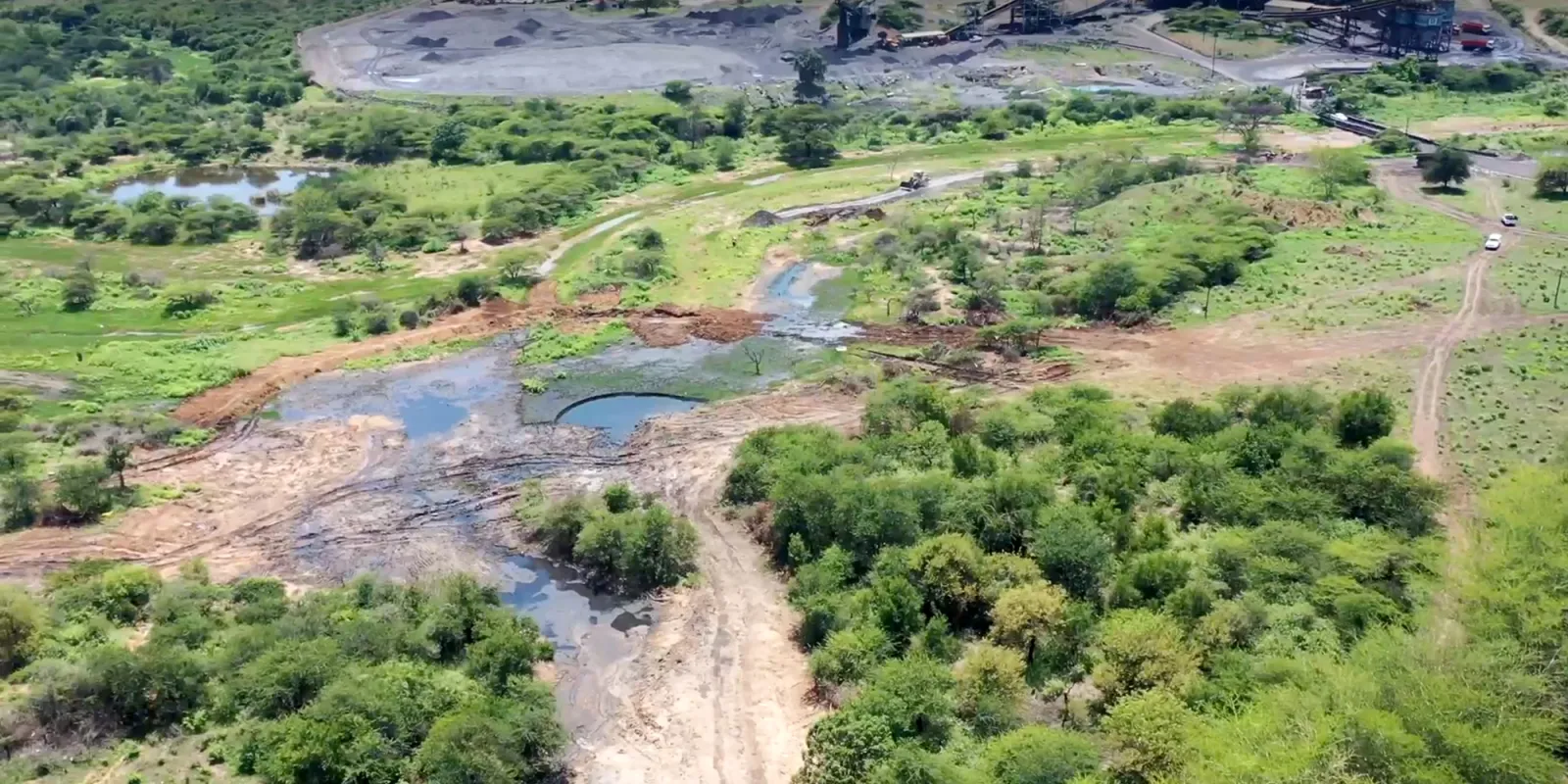
A general view of a slurry pond spill incident at Zululand Anthracite Colliery, 19 January 2022. (Photo: Twitter / @Zulac_SA)
By Kirsten Youens | 30 Jun 2022
What is happening with coal mining in northern KwaZulu-Natal in a Freshwater Ecosystem Priority Area is a war on water and our climate resilience.
--------------------------------------------------------------------------------------------------------------------------------------------------------------------
“The southern white rhino has been to the brink of extinction and back, but even as it continues to be under threat from poachers, its survival is largely thanks to the conservation work of one park. Today, most of these rhinos can trace their ancestry back to the Hluhluwe-iMfolozi Park (HiP) in KwaZulu-Natal, South Africa,” CNN reported in June 2020.
It was Ian Player and his mentor, Magqubu Ntombela, a game ranger and descendant of the great Zulu chiefs, Shaka and Dingaan, who set up wilderness trails in the iMfolozi and sparked a global wilderness consciousness movement.
As Player wrote, “everyone who comes to the wilderness is changed by it, no one who sleeps on the ground underneath the blaze of southern stars and hears the roar of the lion, the coughing of the leopard, the howl of the hyena, the scream of the elephant and smells the smoke of wild wood burning is ever the same again.”
And in what must be recognised as one of the greatest conservation achievements of all time, Ian Player’s “Operation Rhino” achieved a 1,000% growth in the white rhino population in the 1960s saving the 40 Southern White Rhino left in the 1940s from extinction. Operation Rhino took place in the Hluhluwe-iMfolozi Park which is also the oldest proclaimed game reserve in Africa, having been established in 1895.
The Park sits on a coal belt and has, for over two decades, been subjected to the difficulties of having two coal mines as its neighbours on both its north and east boundary. Coal mining is polluting, noisy and not a good neighbour for the communities they inflict their pollution on nor the wild areas where animals and people live peacefully and, (gasp) even thrive. It seems utterly bizarre that coal mining would be given a place adjacent to ancient wild heritage and centuries-old Zulu culture — but that’s exactly what happened.
And continues to happen. The situation as it stands today is that there are three prospecting applications — for coal mining on the western and southern borders of the Hluhluwe-iMfolozi Game Reserve respectively — and two coal mine expansion applications (for coal on the western and eastern borders of the Hluhluwe-iMfolozi Game Reserve respectively) as well as several in the near vicinity.
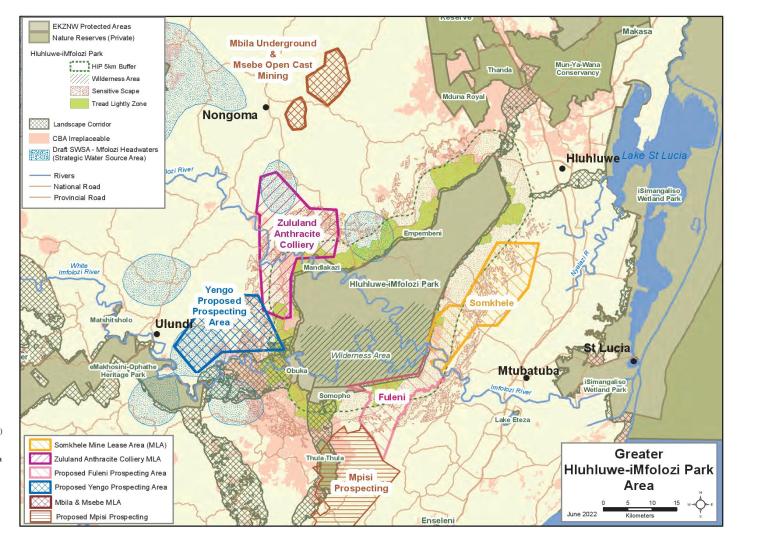
A map of all mining operations in the area. (Graphic: Supplied)
One of the main causes of the climate crisis is the fossil fuel industry which, particularly in South Africa, is still being pursued in spite of the damage it causes to the environment and at grassroots level in the communities in which the mining takes place.
Coal mining repeatedly forecloses on alternative, more sustainable land uses; undermines biodiversity conservation efforts; impacts heavily on water resources; strips people of their land rights; destroys subsistence-based livelihoods and cultural heritage; causes division in the community; and erodes people’s right to an environment that is not harmful to their health or wellbeing — a right afforded to them by Section 24 of the Constitution, 1996.
Freshwater ecosystems, including rivers and wetlands, are particularly vulnerable to coal mining and related activities that can often result in irreversible damage or longer-term gradual, cumulative impacts. Coal mining will result in significantly reduced water quality due to acidification and ferric sulphate (which kills fish and other aquatic fauna), hydrocarbons, coal dust and nitrate deposition, together with high turbidity.
South Africa has 22 water source areas which are the source of our five major river systems and which support approximately 60% of South Africa’s population. The Mfolozi Headwaters is one of these areas with the Black Mfolozi, Pongola and Lenjane Rivers being the main rivers which flow from Mfolozi Headwaters. It feeds a number of free-flowing rivers including the Mkuze, Nsonge, Ndonweni, Ngogo, Mfule and Nyalazi.
Three Ramsar Sites: Kosi Bay, Lake Sibaya and St Lucia system fall within this water source area.
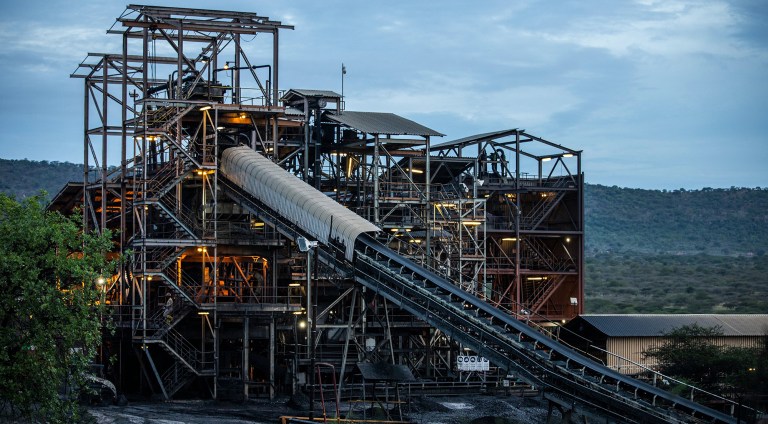
A general view of Zululand Anthracite Colliery. (Photo: Twitter / @Zulac_SA)
The Mnyaba and Nyalazi river systems are classified as nationally important Freshwater Ecosystem Priority Areas (Fepas), the Mnyaba river has a “medium-high” Ecological Importance and Sensitivity (EIS) rating and Nyalazi River has been rated medium in terms of EIS. The White Mfolozi is identified as being a strategic spatial priority for conserving South Africa’s freshwater ecosystems and supporting sustainable water resources.
The St Lucia Estuary is one of the main components of the iSimangaliso Wetland Park, a Unesco World Heritage Site. The estuary is by nature dynamic. It is driven, at any given point in time, by five rivers and sea water inflows through an estuarine mouth. Of the rivers, the Mfolozi is the largest. The wetland park supports a range of plant, bird, fish, and animal species.
All of these mines and prospecting applications fall within the Mfolozi Catchment or are situated along the Mfolozi River. The Black Mfolozi flows through ZACs mining right area and into the Hluhluwe-iMfolozi Park. A drainage line flows through Zululand Anthracite Colliery’s (ZAC) Nqolothi coal siding (which stockpiles coal for transport) and into the Nhlungwane stream, which is a tributary of the Mfolozi River. ZAC abstracts water from the Black Mfolozi River in an amount we are unable to ascertain but the annual water requirement for its proposed expansion is 190,453.69m3 per annum.
According to Tendele’s water licence (which we have appealed to the Water Tribunal) it abstracts up to 750,000m3 per annum from the Mfolozi River and abstracts (by way of dewatering) 2.5-million m3 per annum from the ground.
According to South Africa’s National Climate Change Adaptation Strategy, 2019 (approved in August 2020), access to fresh water, which is already a major challenge in these areas, is predicted to become a much bigger problem as the climate crisis intensifies, with potentially devastating effects. South Africa is to experience drier conditions overall with higher water demand and deteriorating water quality in river systems, water storage reservoirs and groundwater. Our current water usage already exceeds reliable yield.
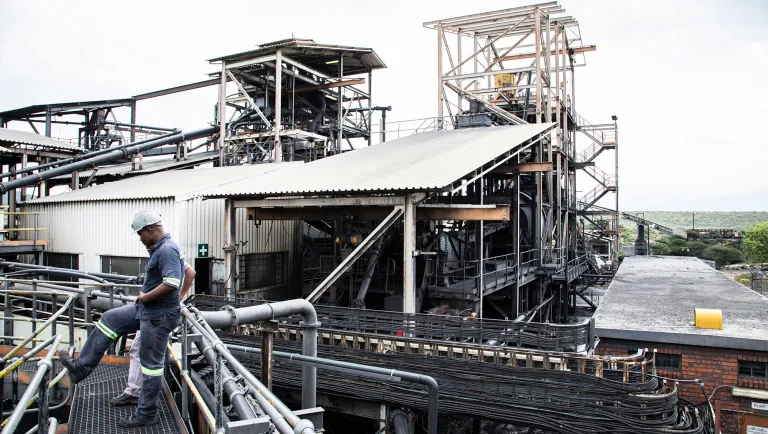
A general view of Zululand Anthracite Colliery. (Photo: zac.co.za)
In most climate-crisis scenarios projected for South Africa, future water supply availability will worsen considerably by 2050. Decreased availability of water in rivers is a result of the net effect of increased temperatures and increased evaporation, combined with shifts in the timing and amount of rainfall; changes in the timing of high and low flows due to changes in rainfall patterns; and a higher incidence of floods as heavy rainfall events increase.
According to the Adaptation Strategy, in the event of future water shortages, meeting the reserve (i.e. water quality and quantity needed to satisfy basic human needs and protect aquatic ecosystems to ensure ecologically sustainable development) must take priority over water uses in the mining sector. If basic human and environmental needs are not given precedence, as required, this could have significant impacts for environmental and human health — resulting in breaches of fundamental constitutional rights to a healthy environment and the right of access to sufficient food and water.
Essentially, what is happening in northern KwaZulu-Natal, in a Freshwater Ecosystem Priority Area, is a war on water and our climate resilience.
To have any more mining and prospecting rights issued on top of all the current mining is evidence that the Department of Mineral Resources and Energy (DMRE) has absolutely no intention of protecting the natural areas of the country or meeting our climate commitments. What DMRE is doing is showing complete disregard for any other department in government and for the people of South Africa.
If not for community organisations and civil society opposing these many applications, there is no doubt that DMRE would just grant all the applications that come its way. With environmental authorisations also being issued by DMRE, both the environmental authorisation and the mining right are granted without issue or delay.
Unless they are opposed by us, the people.
Let’s be honest. No one wants to drive through the wasteland of filth that is an open-cast coal mine before entering a game reserve. No one wants to spend time in a wilderness area when the light and noise pollution from a mine ruins the experience. No one and no animal wants to drink water from a river that is polluted by mine waste. No person would choose to live next to a mine and be exposed to dust, noise and pollution every day.
While the world moves away from coal, South Africa welcomes more and more. What DMRE is doing by issuing mining licences in this area is nothing short of ecocide. DM/OBP
Kirsten Youens is the founder and Chief Executive Director of All Rise, a non-profit organisation and registered law clinic for climate and environmental justice based in Durban, KwaZulu-Natal. She has been practicing as an attorney since 1999, specialising in environmental law. She holds B Soc Sci, LLB and LLM (cum laude) degrees, all from the University of Natal.

A general view of a slurry pond spill incident at Zululand Anthracite Colliery, 19 January 2022. (Photo: Twitter / @Zulac_SA)
By Kirsten Youens | 30 Jun 2022
What is happening with coal mining in northern KwaZulu-Natal in a Freshwater Ecosystem Priority Area is a war on water and our climate resilience.
--------------------------------------------------------------------------------------------------------------------------------------------------------------------
“The southern white rhino has been to the brink of extinction and back, but even as it continues to be under threat from poachers, its survival is largely thanks to the conservation work of one park. Today, most of these rhinos can trace their ancestry back to the Hluhluwe-iMfolozi Park (HiP) in KwaZulu-Natal, South Africa,” CNN reported in June 2020.
It was Ian Player and his mentor, Magqubu Ntombela, a game ranger and descendant of the great Zulu chiefs, Shaka and Dingaan, who set up wilderness trails in the iMfolozi and sparked a global wilderness consciousness movement.
As Player wrote, “everyone who comes to the wilderness is changed by it, no one who sleeps on the ground underneath the blaze of southern stars and hears the roar of the lion, the coughing of the leopard, the howl of the hyena, the scream of the elephant and smells the smoke of wild wood burning is ever the same again.”
And in what must be recognised as one of the greatest conservation achievements of all time, Ian Player’s “Operation Rhino” achieved a 1,000% growth in the white rhino population in the 1960s saving the 40 Southern White Rhino left in the 1940s from extinction. Operation Rhino took place in the Hluhluwe-iMfolozi Park which is also the oldest proclaimed game reserve in Africa, having been established in 1895.
The Park sits on a coal belt and has, for over two decades, been subjected to the difficulties of having two coal mines as its neighbours on both its north and east boundary. Coal mining is polluting, noisy and not a good neighbour for the communities they inflict their pollution on nor the wild areas where animals and people live peacefully and, (gasp) even thrive. It seems utterly bizarre that coal mining would be given a place adjacent to ancient wild heritage and centuries-old Zulu culture — but that’s exactly what happened.
And continues to happen. The situation as it stands today is that there are three prospecting applications — for coal mining on the western and southern borders of the Hluhluwe-iMfolozi Game Reserve respectively — and two coal mine expansion applications (for coal on the western and eastern borders of the Hluhluwe-iMfolozi Game Reserve respectively) as well as several in the near vicinity.

A map of all mining operations in the area. (Graphic: Supplied)
One of the main causes of the climate crisis is the fossil fuel industry which, particularly in South Africa, is still being pursued in spite of the damage it causes to the environment and at grassroots level in the communities in which the mining takes place.
Coal mining repeatedly forecloses on alternative, more sustainable land uses; undermines biodiversity conservation efforts; impacts heavily on water resources; strips people of their land rights; destroys subsistence-based livelihoods and cultural heritage; causes division in the community; and erodes people’s right to an environment that is not harmful to their health or wellbeing — a right afforded to them by Section 24 of the Constitution, 1996.
Freshwater ecosystems, including rivers and wetlands, are particularly vulnerable to coal mining and related activities that can often result in irreversible damage or longer-term gradual, cumulative impacts. Coal mining will result in significantly reduced water quality due to acidification and ferric sulphate (which kills fish and other aquatic fauna), hydrocarbons, coal dust and nitrate deposition, together with high turbidity.
South Africa has 22 water source areas which are the source of our five major river systems and which support approximately 60% of South Africa’s population. The Mfolozi Headwaters is one of these areas with the Black Mfolozi, Pongola and Lenjane Rivers being the main rivers which flow from Mfolozi Headwaters. It feeds a number of free-flowing rivers including the Mkuze, Nsonge, Ndonweni, Ngogo, Mfule and Nyalazi.
Three Ramsar Sites: Kosi Bay, Lake Sibaya and St Lucia system fall within this water source area.

A general view of Zululand Anthracite Colliery. (Photo: Twitter / @Zulac_SA)
The Mnyaba and Nyalazi river systems are classified as nationally important Freshwater Ecosystem Priority Areas (Fepas), the Mnyaba river has a “medium-high” Ecological Importance and Sensitivity (EIS) rating and Nyalazi River has been rated medium in terms of EIS. The White Mfolozi is identified as being a strategic spatial priority for conserving South Africa’s freshwater ecosystems and supporting sustainable water resources.
The St Lucia Estuary is one of the main components of the iSimangaliso Wetland Park, a Unesco World Heritage Site. The estuary is by nature dynamic. It is driven, at any given point in time, by five rivers and sea water inflows through an estuarine mouth. Of the rivers, the Mfolozi is the largest. The wetland park supports a range of plant, bird, fish, and animal species.
All of these mines and prospecting applications fall within the Mfolozi Catchment or are situated along the Mfolozi River. The Black Mfolozi flows through ZACs mining right area and into the Hluhluwe-iMfolozi Park. A drainage line flows through Zululand Anthracite Colliery’s (ZAC) Nqolothi coal siding (which stockpiles coal for transport) and into the Nhlungwane stream, which is a tributary of the Mfolozi River. ZAC abstracts water from the Black Mfolozi River in an amount we are unable to ascertain but the annual water requirement for its proposed expansion is 190,453.69m3 per annum.
According to Tendele’s water licence (which we have appealed to the Water Tribunal) it abstracts up to 750,000m3 per annum from the Mfolozi River and abstracts (by way of dewatering) 2.5-million m3 per annum from the ground.
According to South Africa’s National Climate Change Adaptation Strategy, 2019 (approved in August 2020), access to fresh water, which is already a major challenge in these areas, is predicted to become a much bigger problem as the climate crisis intensifies, with potentially devastating effects. South Africa is to experience drier conditions overall with higher water demand and deteriorating water quality in river systems, water storage reservoirs and groundwater. Our current water usage already exceeds reliable yield.

A general view of Zululand Anthracite Colliery. (Photo: zac.co.za)
In most climate-crisis scenarios projected for South Africa, future water supply availability will worsen considerably by 2050. Decreased availability of water in rivers is a result of the net effect of increased temperatures and increased evaporation, combined with shifts in the timing and amount of rainfall; changes in the timing of high and low flows due to changes in rainfall patterns; and a higher incidence of floods as heavy rainfall events increase.
According to the Adaptation Strategy, in the event of future water shortages, meeting the reserve (i.e. water quality and quantity needed to satisfy basic human needs and protect aquatic ecosystems to ensure ecologically sustainable development) must take priority over water uses in the mining sector. If basic human and environmental needs are not given precedence, as required, this could have significant impacts for environmental and human health — resulting in breaches of fundamental constitutional rights to a healthy environment and the right of access to sufficient food and water.
Essentially, what is happening in northern KwaZulu-Natal, in a Freshwater Ecosystem Priority Area, is a war on water and our climate resilience.
To have any more mining and prospecting rights issued on top of all the current mining is evidence that the Department of Mineral Resources and Energy (DMRE) has absolutely no intention of protecting the natural areas of the country or meeting our climate commitments. What DMRE is doing is showing complete disregard for any other department in government and for the people of South Africa.
If not for community organisations and civil society opposing these many applications, there is no doubt that DMRE would just grant all the applications that come its way. With environmental authorisations also being issued by DMRE, both the environmental authorisation and the mining right are granted without issue or delay.
Unless they are opposed by us, the people.
Let’s be honest. No one wants to drive through the wasteland of filth that is an open-cast coal mine before entering a game reserve. No one wants to spend time in a wilderness area when the light and noise pollution from a mine ruins the experience. No one and no animal wants to drink water from a river that is polluted by mine waste. No person would choose to live next to a mine and be exposed to dust, noise and pollution every day.
While the world moves away from coal, South Africa welcomes more and more. What DMRE is doing by issuing mining licences in this area is nothing short of ecocide. DM/OBP
Kirsten Youens is the founder and Chief Executive Director of All Rise, a non-profit organisation and registered law clinic for climate and environmental justice based in Durban, KwaZulu-Natal. She has been practicing as an attorney since 1999, specialising in environmental law. She holds B Soc Sci, LLB and LLM (cum laude) degrees, all from the University of Natal.
"Education is the most powerful weapon which you can use to change the world." Nelson Mandela
The desire for equality must never exceed the demands of knowledge
The desire for equality must never exceed the demands of knowledge


